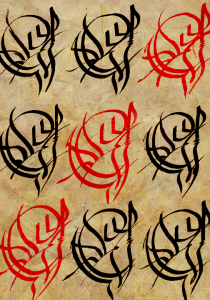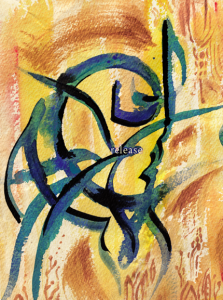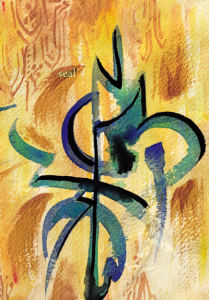Apologies for the silence, folks. Like many of you, I’ve had relatives in town this week, and the sheer bombardment of family demands plus holiday demands and work demands and oh yeah writing demands, has pretty much eaten me alive. But I’ll have some enforced free time in the next few days because holy crap, Snowpocalypse 2: Brooklyn Boogaloo, has begun. We’re expecting 10-15 inches in the next day or two. I don’t have to go to work, though, and I’ve got plenty of apple cider and a snuggly cat to keep me warm, so I think it’s time to catch up on blog posts.
To start off, here’s a visual treat courtesy of artist Mia Sereno. I won a sample of Mia’s work through a charity auction for Haiti that I participated in earlier this year, and she offered to come up with some renderings of scriveners’ sigils. I didn’t give her much to go on, since I’m not a very visual person, and also because I didn’t want to interfere with her interpretation of the passages describing sigils in The Hundred Thousand Kingdoms. But here’s what I did tell her:
OK, so in this world, the way that magicians — called “scriveners” — do
magic is to write in characters of the gods’ language. They do this either
using single characters (sigils) or a series of characters (a script),
usually written right to left. Direction doesn’t actually matter. A single
character can have a very powerful effect, and the strength of the effect is
impacted by varying the heaviness/width of the strokes. For example, the
character for “travel” can cause things to teleport on contact. Drawn with
fine lines, this character acts like an elevator, causing people to pass
through floors and walls…. In my head, the sigils are
sort of circular/radial. At one point they’re described as “spidery” or
like a spiderweb. Sigils are always drawn in black ink, usually on white
paper, though they can be put on anything — skin, cloth, glass. What
matters is precision: every line must be drawn exactly right, or the sigil
either won’t work or will backfire. The sigil won’t “activate” until the
final line is drawn, so many scriveners will carry around nearly-finished
sigils on sheets of paper, and just draw the final line when they’re ready
to use the thing. (Of course, this is dangerous, because if the ink smears
before they use it, or something accidentally marks the paper, Bad Things
could happen.)
And here’s what she came up with! Click for larger versions:



So pretty! And powerful. The first image, as the caption notes, is Mia’s interpretation of a “practice sheet” that a scrivener in training might draw on a daily basis, in order to master a given sigil. The latter two images are final versions — rather more artful than what most scriveners would draw, but still lovely. Mia adds, “I would imagine, to keep the symbols from actually invoking any power, one might hold back on the final stroke? I do not know, but I had fun thinking about it!”
So consider this a Christmas gift from her and me.
Very nice! I particularly like how the practice sheet both says Sky and resembles a tree.
These are beautiful! I really like the way the intertwining words and colours work together.
Wow! How cool! I love them. Thank you for sharing. :-)
hello! i literally just finished reading the first book ( and have ordered the second shipping speeds better not get messed up with these snow storms lol )
Just wanted to say what an incredible story you have begun to tell! i cannot wait to devour the second book!
the sigles are interesting, it concept kinda reminds me of Le Guin’s (and others) concept of names, and how names have power,to influence the thing and concept of the thing/ not sure why i am drawing that association but i am. Again excellent work!